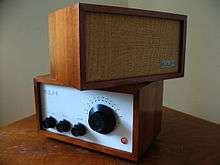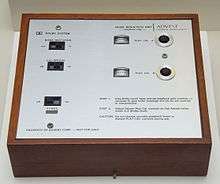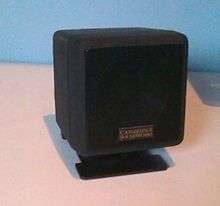Henry Kloss
| Henry Kloss | |
|---|---|
| Born |
February 21, 1929 Altoona, Pennsylvania, United States |
| Died |
January 31, 2002 (aged 72) Cambridge, Massachusetts, United States |
| Nationality | US |
| Occupation |
|
Henry Kloss (February 21, 1929, January 31, 2002) was a prominent American audio engineer and entrepreneur who helped advance high fidelity loudspeaker and radio receiver technology beginning in the 1950s.[1] Kloss (pronounced with a long o, like "close") was an undergraduate student in physics at the Massachusetts Institute of Technology (class of 1953), but never received a degree. He was responsible for a number of innovations, including, in part, the acoustic suspension loudspeaker, and the high fidelity cassette deck. In 2000, Kloss was one of the first inductees into the Consumer Electronics Association's Hall of Fame. He earned an Emmy Award for his development of a projection television system, the Advent VideoBeam 1000.
Career
During the course of his half-century career, Kloss founded or co-founded several significant audio and video equipment manufacturing companies, most of which were located in Cambridge, Massachusetts, at least during the period he was directly associated with them.
After entering MIT in 1948, Kloss bought woodworking tools which he used to make enclosures for a speaker designed by an MIT professor and his student. Henry dropped out of MIT, and soon after took a course in high fidelity taught by Edgar Villchur at New York University.
Kloss was an early adopter of new technology, including the transistor, Dolby noise reduction, and chromium dioxide tape.[2]
Kloss Industries
In the early 1950s, Kloss built (but did not design) the Baruch-Lang speaker in his loft in Cambridge while he was a student at MIT. This corner speaker had four 5" drivers ("and 15 holes"), and sold for $25 (or $30 for the Deluxe Model "with a handsome frame and grill cloth").
Acoustic Research
Kloss co-founded Acoustic Research Corporation (AR) with Edgar Villchur in 1954. Villchur, a former teacher of Kloss, had conceived a novel way of building an accurate loudspeaker. Together they developed the AR Model 1, which changed the way that speakers were designed. Until then, speakers of quality had to be quite large. By using an enclosure with a sealed air cavity behind the speaker cone which acted as a spring to damp woofer motion, they were able to make less-expensive, bookshelf-size speakers. Although they were inefficient in power consumption compared to ported designs, they had extremely low distortion. The AR-1 was the first commercial acoustic suspension loudspeaker.
KLH - KLH Research and Development Corporation

Kloss began his custom of eponymous products by lending his last name's initial to KLH as a founder in 1957, along with Malcolm Low and J. Anton Hofmann (son of pianist Józef Hofmann) who had also been investors in AR. At Cambridge-based KLH, Kloss continued to build speakers such as the classic KLH Model Five and Six, and produced one of the first small FM radios with high selectivity, the Model Eight. The KLH Nine was the world's first full range (flat from 40 Hz - 20 kHz) electrostatic loudspeaker (1960). The tweeter was mounted near the middle, with ten woofer panels occupying the remaining area. Prototypes were completed at JansZen Laboratory and put into field tests starting in 1957, and once perfected, the speakers were put into production at KLH.
Though KLH was sold to the Singer Corporation in 1964, Kloss remained at the firm for a short time to assist in the development of additional speakers and electronic music products, and the firm continued to attract design and engineering talent. Kloss created the first solid state record player, the KLH Model Eleven. In 1962, he collaborated with Ray Dolby of Dolby Laboratories to develop the "B" version of the Dolby noise reduction system to reduce tape hiss. This resulted in the KLH Model Forty reel-to-reel tape recorder, the first appearance of Dolby technology in the consumer product market.
By 1967, Kloss had left KLH. KLH was eventually sold to Kyocera, and production was shifted overseas. By 1979, nearly all of the original design and engineering team had left the company.
Advent Corporation

Kloss founded Advent Corporation in 1967. Around 1968, Kloss had quit KLH to develop a low-cost projection television, but had trouble financing the leading-edge research and development that was still required. To earn some money, he decided to build a high-performance low-cost dual driver speaker system, The Advent Loudspeaker.
Advent later created other speakers and a high-fidelity cassette tape player and recorder incorporating Dolby B noise reduction.
In 1972, the Advent VideoBeam 1000 was finally released, the first large screen projection television for home use.
Kloss Video Corporation
In 1977, Kloss founded Kloss Video Corporation (KVC) as a spin-off company. He invented the Novatron tube there, which increased the efficiency of projection TVs.
Cambridge SoundWorks

Cambridge SoundWorks was founded by Kloss and Tom DeVesto in 1988. That company was quite successful, producing dozens of different models of speakers. They also produced table radios and high quality speaker systems for computers. Kloss left Cambridge SoundWorks in 1996, and the company became a subsidiary of Creative Technology.
Tivoli Audio

Former Cambridge SoundWorks co-founder Tom DeVesto founded Tivoli Audio in 2000 to sell the table radio Kloss designed after a brief retirement. Tivoli made the Model One (mono) and Model Two (stereo) table radios using MOSFET technology to increase selectivity; they have elements similar in appearance to Kloss' KLH Model Eight radio. The high-quality tuner combined with a good speaker arrangement led some reviewers to call these modern radios "Bose killers". However, the Cambridge SoundWorks Model 88 had used some similar technology, leading to a lawsuit between Cambridge Soundworks and Tivoli Audio.[3]
References
- ↑ SCHWARTZ, JOHN (February 5, 2002). "Henry Kloss, 72, Innovator In Audio and Video, Dies". The New York Times. Retrieved May 4, 2014.
- ↑ Lander, David (February 10, 2002). "Henry Kloss, Dead at 72". Stereophile. Retrieved September 21, 2015.
- ↑ "The People of Tivoli Audio and the Design of Henry Kloss Radios". Totally Wired NZ. February 12, 2002. Retrieved September 21, 2015.
- Stereophile obituary
- Wes Phillips (2002) Henry Kloss: The Man Who Changed Audio and Video
- CE Hall of Fame: Henry Kloss. Consumer Electronics Association.
- Interview with Tom DeVesto, co-founder of Tivoli Audio
External links
| Wikimedia Commons has media related to Henry Kloss. |
- About KLH.
- KLH Model Eight table radio illustrated.
- Advent fan page